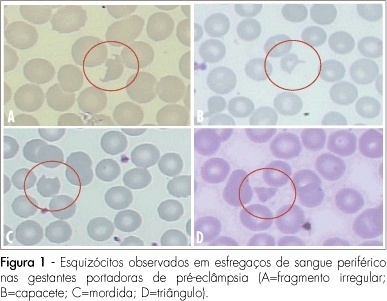Summary
Revista Brasileira de Ginecologia e Obstetrícia. 2008;30(8):413-419
DOI 10.1590/S0100-72032008000800007
PURPOSE: to evaluate the meiotic spindle and the chromosome distribution of in vitro mature oocytes from stimulated cycles of infertile women with endometriosis, and with male and/or tubal infertility factors (Control Group), comparing the rates of in vitro maturation (IVM) between the two groups evaluated. METHODS: fourteen patients with endometriosis and eight with male and/or tubal infertility factors, submitted to ovarian stimulation for intracytoplasmatic sperm injection have been prospectively and consecutively selected, and formed a Study and Control Group, respectively. Immature oocytes (46 and 22, respectively, from the Endometriosis and Control Groups) were submitted to IVM. Oocytes presenting extrusion of the first polar corpuscle were fixed and stained for microtubules and chromatin evaluation through immunofluorescence technique. Statistical analysis has been done by the Fisher's exact test, with statistical significance at p<0.05. RESULTS: there was no significant difference in the IVM rates between the two groups evaluated (45.6 and 54.5% for the Endometriosis and Control Groups, respectively). The chromosome and meiotic spindle organization was observed in 18 and 11 oocytes from the Endometriosis and Control Groups, respectively. In the Endometriosis Group, eight oocytes (44.4%) presented themselves as normal metaphase II (MII), three (16.7%) as abnormal MII, five (27.8%) were in telophase stage I and two (11.1%) underwent parthenogenetic activation. In the Control Group, five oocytes (45.4%) presented themselves as normal MII, three (27.3%) as abnormal MII, one (9.1%) was in telophase stage I and two (18.2%) underwent parthenogenetic activation. There was no significant difference in meiotic anomaly rate between the oocytes in MII from both groups. CONCLUSIONS: the present study data did not show significant differences in the IVM or in the meiotic anomalies rate between the IVM oocytes from stimulated cycles of patients with endometriosis, as compared with controls. Nevertheless, they have suggested a delay in the outcome of oocyte meiosis I from patients with endometriosis, shown by the higher proportion of oocytes in telophase I observed in this group.

Summary
Revista Brasileira de Ginecologia e Obstetrícia. 2008;30(8):406-412
DOI 10.1590/S0100-72032008000800006
PURPOSE: to evaluate the significance of schizocytes presence in peripheral blood smear of pregnant women with pre-eclampsia, identifying and correlating them with other markers of hemolysis and of the disease severity. METHODS: Seventh six glass slides of peripheral blood smear of pregnant women with pre-eclampsia have been evaluated. After the smear, the slides have been stained with Leishman's dye and stored till they were examined with a Leica, model DLMB microscope, provided with the Qwin Lite 2.5 software that made it possible to record the images of selected fields in CD-ROM. Ten fields with approximately 100 erythrocytes were counted in each glass slide. Schizocytes (irregular fragment or helmet-shaped, bite-shaped or triangular) were considered as present, when their percentage was equal or higher than 0.2%, their presence being correlated with other hemolysis markers (hemoglobin, total bilirubin, lactic desidrogenasis and reticulocytes), pre-eclampsia markers (proteinuria and platelet number). The Statistical Package in Social Science for Windows (SPSS), 10.0 version has been used for statistical analysis, at p<0.05. RESULTS: schizocytes have been present in 31.6% of the pregnant women with pre-eclampsia. In most (75%) of the blood smears there have been three or four schizocytes. There has been no correlation between schizocyte presence and any other hemolysis marker, any pre-eclampsia marker or disease severity. CONCLUSIONS: schizocytes have been identified in a small number and in less than a third of the pregnant women with pre-eclampsia. There has been no correlation with other hemolysis marker parameters or with the disease severity. This way, the presence of schizocytes is not a marker of the clinical evolution of pre-eclampsia.

Summary
Revista Brasileira de Ginecologia e Obstetrícia. 2008;30(8):393-399
DOI 10.1590/S0100-72032008000800004
PURPOSE: to study cervical colonization in women with preterm labor or premature rupture of membranes. METHODS: two hundred and twelve pregnant women with preterm labor or premature rupture of membranes were studied. Two cervical samples from each woman were collected and bacterioscopy and culture were performed. Association of cervical microorganisms and urinary tract infection, chorioamnionitis, fetal stress, antibiotic use, prematurity, neonatal infection, and neonatal death were evaluated. RESULTS: the prevalence of endocervical colonization was 14.2% (CI95%=9.5-18.9%), with similar results in preterm labor or premature rupture of membranes. Group B streptococcus was the most prevalent organism (9.4%). Other organisms isolated were Candida sp, Streptococcus sp, Streptococcus pneumoniae, Escherichia coli and Enterococcus sp. The most common findings of bacterioscopy were a reduced number of lactobacilli and a great number of leukocytes. Endocervical colonization was associated with a higher occurrence of urinary tract infection (23.8 versus 5.4%; p<0.01), early-onset neonatal infection (25.0 versus 7.3%; p<0.01) and neonatal mortality (two cases in colonized women; p<0.02) when compared with a negative culture of endocervical mucus. CONCLUSIONS: this study showed high prevalence of endocervical colonization despite the use of a nonselective culture media. The main microorganism isolated was group B streptococcus, but other organisms were present in one third of the studied population. More studies are needed to evaluate the influence of endocervical colonization on obstetrical outcome and on neonatal infection and mortality.
Summary
Revista Brasileira de Ginecologia e Obstetrícia. 2008;30(8):384-392
DOI 10.1590/S0100-72032008000800003
PURPOSE: the objective of the present study was the development of the Brazilian Portuguese version of Endometriosis Health Profile Questionnaire (EHP-30), the cross-cultural adaptation to Brazil and the evaluation of EHP-30 Portuguese psychometric measures in a Brazilian sample. METHODS: the original instrument in English was translated into Portuguese following international guidelines, going through all stages of translation, back-translation and comparison of the versions for cross-cultural adaptation, face and content validity. A sample of 54 patients with endometriosis was used for internal consistency analyses using the Cronbach alpha. Test-retest reliability was evaluated through the intraclass correlation coefficient (ICC). In order to evaluate the convergent construct validity, the correlation between EHP-30 Portuguese and WHOQOL-Bref and Beck Depression Inventory (BDI) was tested. RESULTS: internal consistency presented alpha values of 0.8 to 0.9 suggesting homogeneity between questions. The test-retest reliability presented ICC of 0.8 to 0.9 showing instrument stability. In the construct validation, strong correlations were demonstrated of the EHP-30 Portuguese self-image scale with physical (-0.6) and psychological domains (-0.6) of WHOQOL-Bref, and EHP-30 Portuguese social support scale with BDI (0.5), confirming good correlation with other quality of life evaluation instruments. CONCLUSIONS: the EHP-30 Portuguese was found to be an easy, quickly applied instrument, and well-accepted by the patients. It presented good psychometric properties with appropriate reliability measures (internal consistency and test-retest reliability) and construct validity. These results show that EHP-30 Portuguese is an adequate instrument for quality of life evaluation in Brazilian women with endometriosis, both in clinical and research setting.

Summary
Revista Brasileira de Ginecologia e Obstetrícia. 2008;30(8):379-383
DOI 10.1590/S0100-72032008000800002
PURPOSE: to verify the association of osteoporosis with periodontal disease. METHODS: the study has included 39 postmenopausal women divided in three groups according to bone mass categories, through evaluation of mineral bone density (MBD), measured by X-ray double emission absorbimetry in the lumbar area (L1-L4): ): normal bone; osteopenia and osteoporosis. In all the participants the Clinical Insertion Level (CIL) index has been determined at the research onset and after one year, by the same examiner. The periodontal situation data have been submitted to statistical analysis with the paired t-Student test. RESULTS: the periodontal exam has shown that postmenopausal women in the osteopenia presented lower CIL at the initial periodontal clinical exam (2.1±1.1 mm), while the ones in the normal bone showed less teeth support tissue loss after one year (3.1±1.6 mm). The statistical analysis has shown that there was no significant difference for the periodontal situation in the normal bone, but there was significant statistical difference for the osteopenia and osteoporosis patients, when CIL values from both evaluation periods were compared. CONCLUSIONS: it is concluded that postmenopausal osteoporosis may be a possible risk factor for periodontal disease.
Summary
Revista Brasileira de Ginecologia e Obstetrícia. 2008;30(7):349-354
DOI 10.1590/S0100-72032008000700005
PURPOSE: to describe the prevalence and behavioral profile of genital infections in women attended at a Primary Health Unit in Vitoria, ES. METHODS: a transversal study including 14 to 49-year-old women attended by the Family Health Program (FHP). Exclusion criteria were: having been submitted to gynecological examination in less than one year before, and history of recent treatment (in the last three months) for genital infections. An interview including socio-demographic, clinical and behavioral data was applied. Genital specimens were collected for cytology, GRAM bacterioscopy and culture, and urine sample for molecular biological test for Chlamydia trachomatis. RESULTS: two hundred and ninety-nine women took part in the study. The median age was 30.0 (interquartile interval: 24;38) years old; the average age of the first intercourse was 17.3 (sd=3.6) years old. The first pregnancy average age was 19.2 (3.9) years old. About 70% reported up to 8 years of schooling; 5% reported previous Sexually Transmitted Diseases (STD), and 8%, the use of illicit drugs. Only 23.7% reported consistent use of condoms. Clinical complaints were: genital ulcer (3%); dysuria (7.7%); vaginal discharge (46.6%): pruritus (20%) and pelvic pain (18%). Prevalence rates were: Chlamydia trachomatis 7.4%; gonorrhea 2%; trichomoniasis 2%; bacterial vaginosis 21.3%; candidiasis 9.3%; and cytological changes suggestive of HPV 3.3%. In the final logistic regression model, the factors independently associated to genital infections were: abnormal cervical mucus, OR=9.7 (CI95%=5.6-13.7), previous HIV testing, OR=6.5 (CI95%=4.0-8.9), having more than one partner during the previous year, OR=3.9 (CI95%=2.7-5.0), and having more than one partner in life, OR=4.7 (CI95%=2.4-6.8). CONCLUSIONS: results show a high rate of genital infections and the need of preventive measures, such as STD surveys and risk reduction programs for women that look for routine gynecological service.